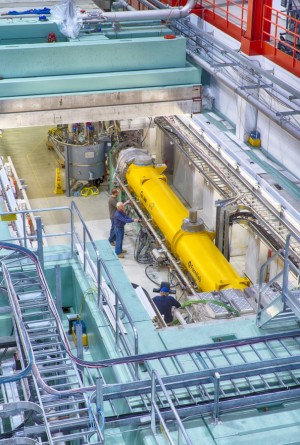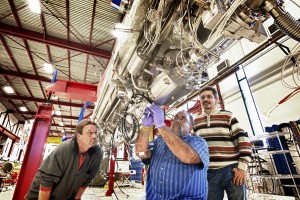For the first time, the ILC gradient specification of 31.5 megavolts per metre has been achieved on average across all of the eight cavities assembled in an ILC-type cryomodule. A team at Fermilab reached the milestone earlier this month. It is an achievement for scientists, engineers and technicians at Fermilab and Jefferson Lab in Virginia as well as their domestic and international partners in superconducting radio-frequency (SRF) technologies.
The cryomodule, called CM2, was developed and assembled to advance superconducting radio-frequency technology and infrastructure at Americas-region laboratories. The CM2 milestone achievement has been nearly a decade in the making, since US scientists started participating in ILC research and development in 2006.
“We’ve reached this important milestone and it was a long time coming,” said Elvin Harms, who leads the cryomodule testing programme at Fermilab. “It’s the first time in the world this has been achieved.”
An accelerating gradient is a measure of how much of an energy boost particle bunches receive as they zip through an accelerator. Cavities with higher gradients boost particle bunches to higher energies over shorter distances. In an operational ILC, all 16,000 of its cavities would be housed in cryomodules, which would keep the cavities cool when operating at a temperature of 2 kelvins. While cavities can achieve high gradients as standalones, when they are assembled together in a cryomodule unit, the average gradient drops significantly.
The road to the 31.5 MV/m milestone has been a long and arduous one. Between 2008 and 2010, all of the eight cavities in CM2 had individually been pushed to gradients above 35 MV/m at Jefferson Lab in tests in which the cavities were electropolished and vertically oriented. They were among 60 cavities evaluated globally for the prospects of reaching the ILC gradient. This evaluation was known as the S0 Global Design Effort. It was a build-up to the S1-Global Experiment, which put to the test the possibility of reaching 31.5 MV/m across an entire cryomodule. The final assembly of the S1 cryomodule setup took place at KEK in Japan, between 2010 and 2011. In S1, seven nine-cell 1.3-gigahertz niobium cavities strung together inside a cryomodule achieved an average gradient of 26 MV/m. An ILC-type cryomodule consists of eight such cavities.

CM2 in its home at Fermilab’s NML building, as part of the future Advanced Superconducting Test Accelerator. Photo: Reidar Hahn
But the ILC community has taken big strides since then. Americas region teams acquired significant expertise in increasing cavity gradients: all CM2 cavities were vertically tested in the United States, initially at Jefferson Lab, and were subjected to additional horizontal tests at Fermilab. Further, cavities manufactured by private vendors in the United States have improved in quality: three of the eight cavities that make up the CM2 cryomodule were fabricated locally.
Hands-on experience played a major role in improving the overall CM2 gradient. In 2007, a kit for Fermilab’s Cryomodule 1, or CM1, arrived from DESY, and by 2010, when CM1 was operational, the workforce had adopted a production mentality, which was crucial for the work they did on CM2.
“I would like to congratulate my Fermilab colleagues for their persistence in carrying out this important work and for the quality of their work, which is extremely high,” said the SRF Institute at Jefferson Lab’s Rongli Geng, who led the ILC high-gradient cavity project there from 2007 to 2012. “We are glad to be able to contribute to this success.”
But achieving the gradient is only the first step, Harms said. “There is still a lot of work left to be done. We need to look at CM2’s longer term performance. And we need to evaluate it thoroughly.”
Among other tasks, the CM2 group will gently push the gradients higher to determine the limits of the technology and continue to understand and refine it. They plan to power and check the magnet—manufactured at Fermilab— that will be used to focus the particle beam passing through the cryomodule. Also in the works is a plan to study the rate at which the CM2 can be cooled down to 2 kelvins and warmed up again. Finally, they expect to send an actual electron beam through CM2 in 2015 to understand better how the beam and cryomodule respond in that setup.
Scientists at Fermilab also expect that CM2 will be used in the Advanced Superconducting Test Accelerator currently under construction at Fermilab’s NML building, where CM2 is housed. The SRF technology developed for CM2 also has applications for light source instruments such as LCLS-II at SLAC in the United States and the European XFEL and DESY’s FLASH.
And it’s definitely a viable option for a future machine like the ILC.


Recent Comments